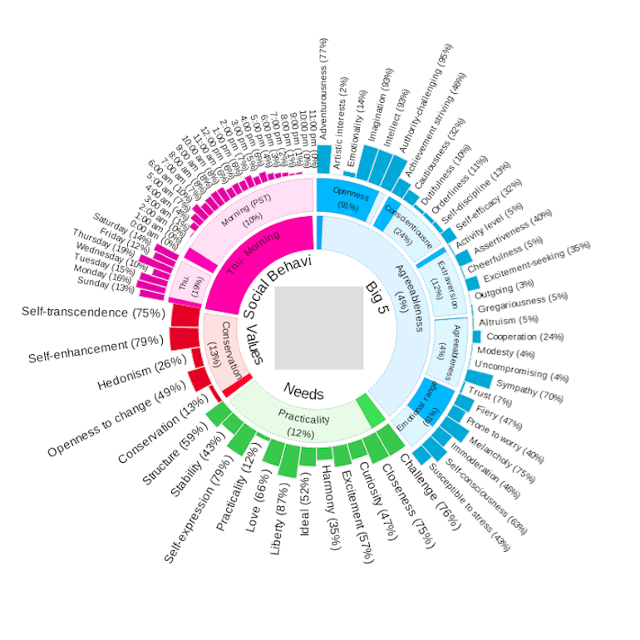IBM Watson: Show me your social media account and I will tell you who you are

An example of personality analysis from IBM Watson The IBM Watson
cognitive system recently studied the identity of NPR journalist Aarti Shahani (at her personal request). For analysis, we used journalist accounts on Facebook and Twitter, as well as a resource such as the Personality Insights API . According to Aarti, the results were very accurate.
At first, the journalist did not even want to publish the information received, but then she decided to take this step. So, Shahani published an example of the results of a computer analysis of her personality in the form of a diagram, which indicates the main features of a person’s character.
“This is a pie chart that shows about 50 character traits, each with a percentage,” the journalist said.
The most obvious trend in Aarti Shahani is a challenge to recognized authorities, Watson rated this characteristic at 95%. The journalist confirmed the correctness of the results.
The cognitive system also appreciated other, less obvious character traits of the journalist. For example, extraversion in this case received only 35%, so it’s impossible to call Shahani very open.
As for the development of IBM, the "mapping" of the characteristics of a person’s character, the technology itself, was developed not so much for use in applied psychology and psychiatry as for other areas, including marketing.
For example, IBM found that people with a high degree of openness and low emotional range (neuroticism) are more favorably inclined to advertisements that they click on most often by visiting various resources. In addition, such individuals more actively retweet other people's news if they are asked about it.
Shahani was surprised at the accurate assessment of her personality that IBM Watson was able to make using both her Facebook account and Twitter. At the same time, the lines of her behavior in one and the other social networks differ, and quite strongly.
“On Facebook, I am me, and Twitter is the place where I turn into a picky know-it-all,” says the journalist. “I thought that the system will give different assessments of my personality using different accounts, but this is not so - the assessment is almost the same, which surprised me,” continues Shahani.
As for the opportunity to fool IBM Watson, it is still unknown how it is necessary to change the style of your messages on the social network so that the system gives a different assessment of the personality. This kind of manipulation, one must think, will become common with the advent of tools like IBM’s open source identity analysis.
“If I know that my potential employer will use this tool to analyze my personality, what can I do to make a more positive assessment?”, The journalist asks. She believes that many people will try to manipulate such tools for a known purpose.
To analyze her personality, the journalist used both available tools (for example, analysis of the writing style) and IBM services, which are still closed to the public.
IBM is now working with partners to bring Personality Insights to the world, using the Watson API as well.
You can listen to the story of Shahani at the link .
